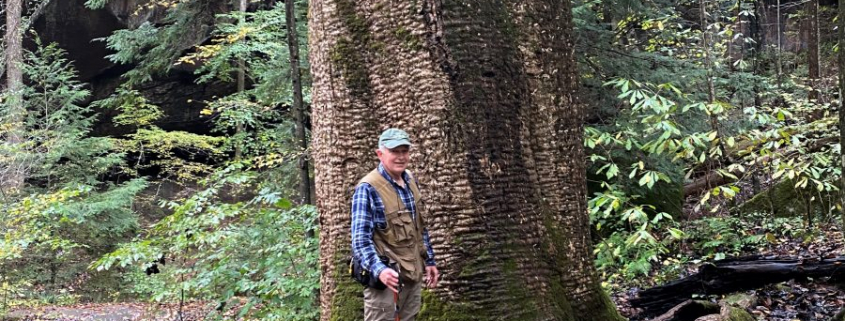An Eleven-mile Bucket List Hike to the Sipsey Big Tree
October 30, 2021, friends and I hiked an eleven-mile circuit to see The Big Tree (State Champion Yellow Poplar) in Alabama’s Bankhead National Forest’s Sipsey Wilderness. I offer reflections on the rough and bouldered terrain, torturous blowdowns, and the majesty of the Big Tree. I reflect upon the hike with threads of bittersweet nostalgia and melancholy.
Allow me to begin at the end. We rushed along the streamside riparian forests, within a quarter mile of the trailhead, long after I had abandoned any thought of returning home by dinner time. Note: the three of us accompanying Randy had miles earlier began to refer to him good-naturedly as “Quarter-Mile Randy.” No matter what landmark, trail juncture, or notable feature we approached, Randy assured us that it lay “just a quarter-mile” ahead! The official sunset that evening occurred at 6:41 PM; the orb sunk beneath the tree canopy and then the hills through which the creek flowed well before then. Randy led us below left as light waned. We had just a few minutes earlier circumvented the last of the impenetrable blowdowns (Randy skirting it below right). His muddy backside evidenced the slipping and sliding we had done throughout the day. We reached our vehicles as darkness enveloped us, a good seven-tenths of a mile from where Randy had told us just a quarter mile to go!
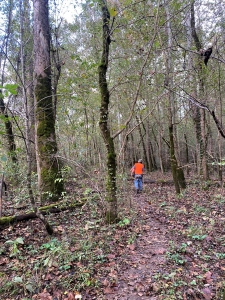
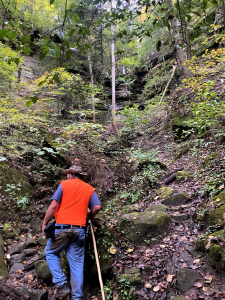
I felt elation at reaching our vehicles before resorting to our flashlights. I admit also to near-exhaustion from a hike that 30 years ago I would have simply considered a nice effort. We hiked October 30, just eight days before my scheduled full left shoulder replacement. I could neither employ my right arm for trekking pole support nor use that arm to steady myself along slippery, rugged, or steep sections. Upon reflection (as I draft this, I am two-and-a-half weeks post-surgery), I realize that for the first time in my adult life, I felt vulnerable, reaching near (exceeding?) my physical limitations. I believe that the stress of uncertainty in my physical constraints contributed to my exhaustion.
Belying my Impressions from Forty Years Ago
A New Understanding and Awakened Eyes
I served as Union Camp Corporation’s Alabama Land Manager 1981-85, responsible for 320,000 acres (500 square miles) of company-owned forestland in the state, two-thirds of it lying south of Alabama’s Black Belt, concentrated in a six-county area of south-central Alabama. Primarily coastal plain (piedmont for the acreage north of Montgomery), our lands were modestly hilly to somewhat flat. During those years, I developed an impression of Alabama’s forests and terrain far different from what I’ve experienced since retirement here in northern Alabama’s southern Appalachian Ridge and Valley, Cumberland Plateau, and Highland Rim regions. I’ve learned that these regions are deeply eroded (geologically), steep-sloped, and laced with numerous streams and drainages. I had carried with me since departing UCC for my doctoral studies in 1985 a picture of Alabama forests as gentle lands, typified by the coastal plain and piedmont.
I’ve learned since retiring that such is not the case in north Alabama. I’ve hiked extensively (and written about it in subsequent Posts) from Oak Mountain to Cheaha to DeSoto to Sand and Lookout Mountains to Monte Sano and elsewhere, that these ancient worn-down mountains, highlands, and plateaus can challenge me at this stage of life.
To the Big Tree
We encountered building-size limestone boulders early in our trek to the Big Tree. Pitted by chemical weathering, the boulders are remnant rimrock. We walked among such massive fractured and detached standing stones along most of the day’s journey. The rocks and these valleys and canyons are ancient. They came to us out of eternity…long after the youngest of us who have hiked to the Big Tree is gone, these landscape elements will still be here. Human time is nothing to a limestone boulder, and canyon, or the streams that reside here.
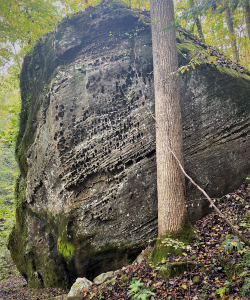

Nor does the duration of a man’s life mean anything to canyon walls still anchored as basement rock. Cliffs bounded us as we progressed. Occasionally they dipped to streamside. These are not the coastal plain flatwoods of my forest industry days. I passed in muted respect for these sheltered canyons. In addition to vulnerable, I felt small and insignificant. As a former manager of vast acreages and a past university president, the essence and spirit of this wild country humbled me, shrunk me to a speck. At times I wanted to sink into a small stone niche to watch, listen, feel, and retreat from all but a solemn respect and awe for this place of wonder. I thought of John Muir.
The clearest way into the Universe is through a forest wilderness.
At times I sensed that I did not truly belong here, that I was the interloper.
The world, we are told, was made especially for man — a presumption not supported by all the facts.
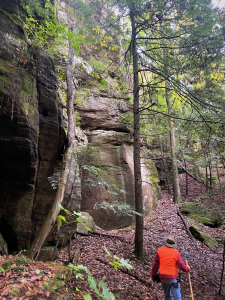
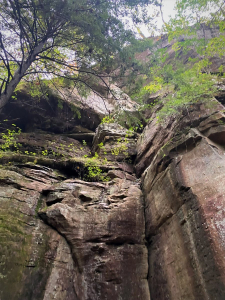
This was not the stereotypical southern forests I remembered. Although I struggled with the rough topography, 12-year-old Jonathan (Randy’s grandson) moved effortlessly through the canyon. That’s him below right.
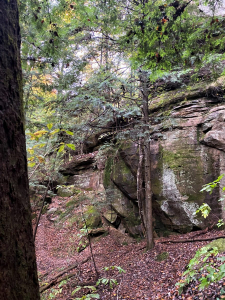
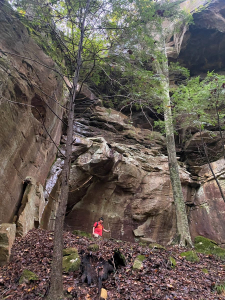
In many places boulders had tumbled to streamside.
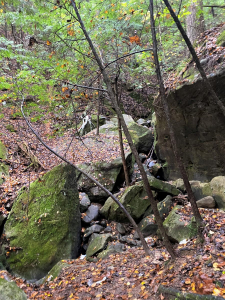
These two house-sized boulders framed our trailside view of the stream.
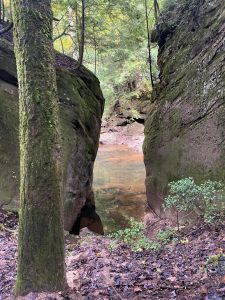
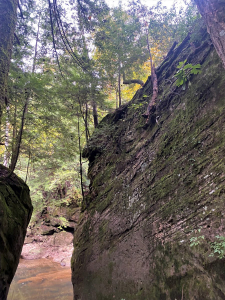
From Rock Barriers to Blowdown Impediments
I offer this photo as a segue, leading me from a focus on rocks to a complementary obstacle to our passage — blowdowns. The tree below has not fallen, but is leaning, eventually earth-bound, a future blowdown.
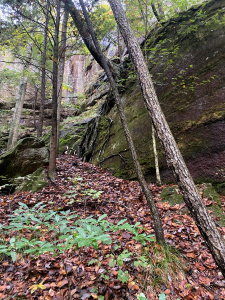
I know I climbed over, through, and around dozens of blowdowns, some massive-crowned beech, poplars, oaks, and others. I remind readers that trail maintenance within a designated Wilderness can be done only with raw muscle, hand tools, and hard labor. No chainsaws or motorized equipment. Imagine hiking several miles, carrying crosscut saws to remove this 30-inch diameter oak. On each encounter we chose among our alternatives: climb over, crawl under, or bushwhack around it.
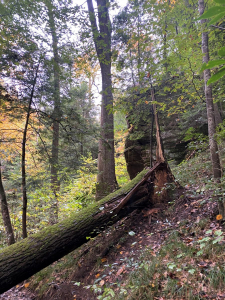
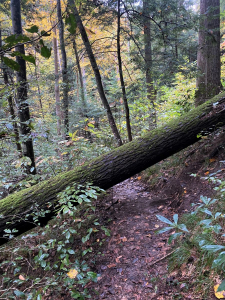
I’ve observed often that life and death operate hand in hand in our forests. The old growth forest in the canyon heading up into the Big Tree’s canyon has recently (within the past 2-4 years) suffered a great deal of blowdown. Stasis does not exist in any living system. Tara is demonstrating quite well the arduous transit from one side of this beech blowdown to another. Now, picture a 70-year-old man with a bum shoulder scrambling (can one scramble in slow motion?) through this obstacle!
‘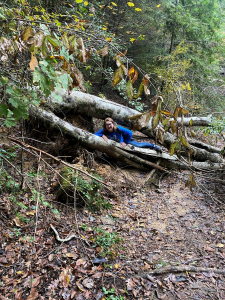
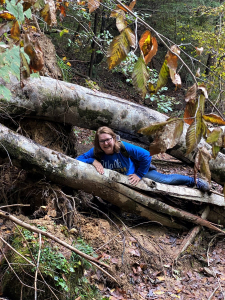
I regret that I did not capture more images of the frequent, haphazardly placed blowdowns.
The Destination
Old growth blowdown obstacles proved nearly impenetrable to my left-shoulder-impeded scrambling. Every time I celebrated a tortured passage, we encountered yet another. Our fearless leader finally said, “Just a quarter-mile to go.” A half-mile later, he said, “I see its top.” I limped into the canyon head, the Big Tree towering above the blind headwall. I sat in awe…resting and eating several granola bars.
As of 2021, the Alabama State Champion Tree Directory shows the Big Tree circumference at 263″ (diameter 6.98′); height at 172′; and crown spread at 102′. The Big Tree’s crown area covers 19,120 square feet, an area of 0.44 acres. Although the national champion yellow poplar scores higher in aggregate, ours certainly ranks among the country’s largest. The national winner, resident of Bedford County Virginia, boasts a 362″ circumference (9.60′ diameter); 139′ height; and 78′ crown spread. Ours is 33 feet taller and its crown spread reaches 24 feet wider. I found nothing on the internet in way of comparison photos. I can’t imagine another yellow poplar that reigns over such a uniquely isolated canyon head as the Big Tree, which singularly owns and commands its three-sided, protected fortress.
Jonathon’s position of recline upon reaching the Big Tree expresses my own feeling.
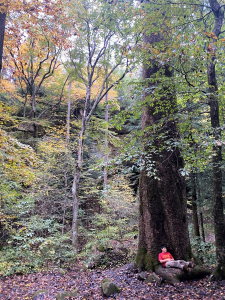
I could attempt to describe my sense of awe and humility standing beside the Big Tree, yet even if given a month, I would fall short of Muir’s words:
Everybody needs beauty…places to play in and pray in where nature may heal and cheer and give strength to the body and soul alike.
I’d rather be in the mountains thinking of God, than in church thinking about the mountains.
I stood there knowing that this first visit to this special place would be my last. Although tired and somewhat worried about our return to the vehicles, I tried to absorb the moment. I plan to carry the place with me all the days of my life. Remembering prior travels, I can close my eyes and see again the California coastal redwoods, the Yosemite sequoias, the Pacific rainforest Douglas fir, the deep cove remnant old growth hardwoods of the Great Smoky Mountains, among others. The Big Tree and its isolated canyon have likewise secured their pages in my tree-memory portfolio!
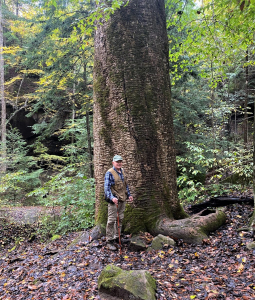
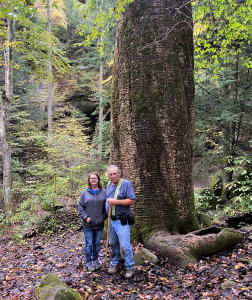
Fall colors enrich my memory.
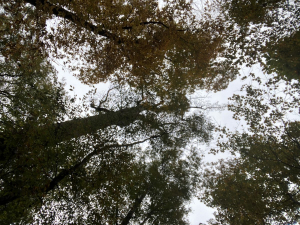

This online file photo from mid-winter more clearly expresses the tree’s full 172′ height.
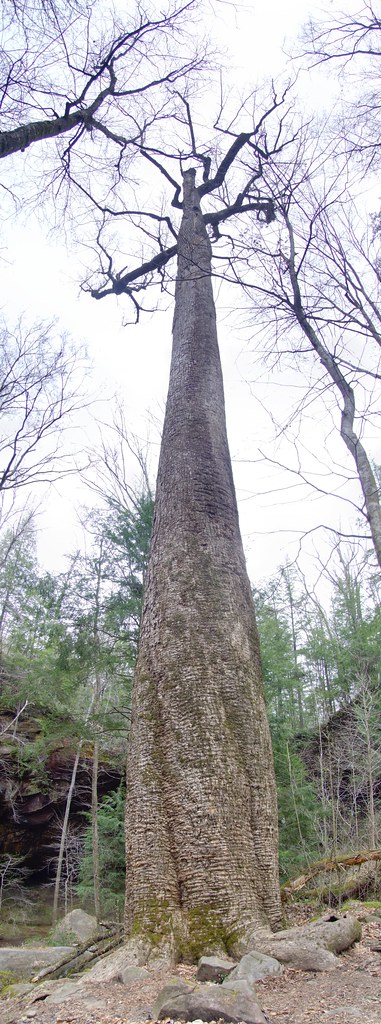
Stock Photo from Web
The canyon alone, even were it absent the Big Tree, is a special niche.
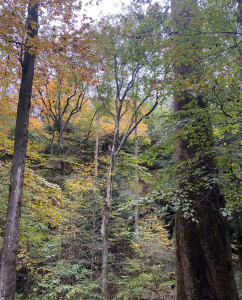
Its waterfall suggests a deeper peace, reminds us of the continuing flow of life, and punctuates the land’s declaration that this is the end…and also the beginning. I did not want to leave, yet knew that I must.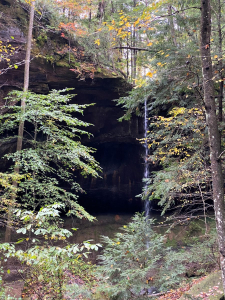
Leaving this sacred place, I wondered whether I would (or could) return. In fact, I was relieved that Randy elected to work our way back to the trailhead via a less harsh, yet longer return. I admittedly felt, for the first time in my life, uncertain whether I could retrace my inbound route with an impaired (and terribly painful) left shoulder, and gimpy knees (osteoarthritis). I felt a deep melancholy, a fear that my life-window for exploring Nature’s magic and mystery was closing. That the universe of new trails to journey was narrowing.
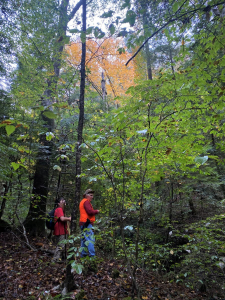
As darkness deepened, we exited the trail. I realized soberly that the day will come when I take my final hike…period, as we all must. Countering my brief deep woe when we began the long and uncertain return hike, I felt absolute joy at having visited the Big Tree and returned to my transportation.
Another Muir quote seems apt:
Most people are on the world, not in it — have no conscious sympathy or relationship to anything about them — undiffused, separate, and rigidly alone like marbles of polished stone, touching but separate.
I am content that on this day I was truly in the world. I write and speak often that every lesson for living, learning, serving, and leading is either written indelibly in or is compellingly inspired by Nature. Such was the case October 30, 2021. Too often, people view a hike as a destination…a passage through the forest. For me, this entire journey served as a destination, each step ventured into and within a forest…not passed through the wildness. I view it through a lens of melancholy…a reminder that I have perhaps passed into a different stage of life…one less daring, gentler, and slowed to a deeper focus on the subtleties instead of the adventurous. I chalk this hike up as the last of a different kind of forest journey. From this day forward, I will change gears, reduce my expectations, and enjoy Nature at a different pace and a lower level of difficulty.
Thoughts and Reflections
I offer these observations:
- Nature rewards most handsomely when we hike into and within the forest, rather than through it.
- Everybody needs beauty…places to play in and pray in where nature may heal and cheer and give strength to the body and soul alike. John Muir.
- Special places reside in our body, mind, heart, soul, and spirit.
Inhale and absorb Nature’s elixir. May Nature Inspire, Inform, and Reward you!
Note: All blog post images created & photographed by Stephen B. Jones unless otherwise noted. Please circulate images with photo credit: “©2021 Steve Jones, Great Blue Heron LLC. All Rights Reserved.”
Another Note: If you came to this post via a Facebook posting or by another route, please sign up now (no cost… no obligation) to receive my Blog Post email alerts: http://eepurl.com/cKLJdL
And a Third: I am available for Nature-Inspired Speaking, Writing, and Consulting — contact me at steve.jones.0524@gmail.com
Reminder of my Personal and Professional Purpose, Passion, and Cause
If only more of us viewed our precious environment through the filters I employ. If only my mission and vision could be multiplied untold orders of magnitude:
Mission: Employ writing and speaking to educate, inspire, and enable readers and listeners to understand, appreciate, and enjoy Nature… and accept and practice Earth Stewardship.
Vision:
- People of all ages will pay greater attention to and engage more regularly with Nature… and will accept and practice informed and responsible Earth Stewardship.
- They will see their relationship to our natural world with new eyes… and will understand more clearly their Earth home.
Tagline/Motto: Steve (Great Blue Heron) encourages and seeks a better tomorrow through Nature-Inspired Living!
Steve’s Three Books
I wrote my books Nature Based Leadership (2016), Nature-Inspired Learning and Leading (2017), and Weaned Seals and Snowy Summits: Stories of Passion for Place and Everyday Nature (2019; co-authored with Dr. Jennifer Wilhoit) to encourage all citizens to recognize and appreciate that every lesson for living, learning, serving, and leading is either written indelibly in or is powerfully inspired by Nature.
I began authoring books and Posts for several reasons:
- I love hiking and exploring in Nature
- I see images I want to (and do) capture with my trusty iPhone camera
- I enjoy explaining those images — an educator at heart
- I don’t play golf!
- I do love writing — it’s the hobby I never needed when my career consumed me
- Judy suggested my writing is in large measure my legacy to our two kids, our five grand kids, and all the unborn generations beyond
- And finally, perhaps my books and Blogs could reach beyond family and touch a few other lives… sow some seeds for the future


All three of my books (Nature Based Leadership; Nature-Inspired Learning and Leading; Weaned Seals and Snowy Summits) present compilations of firsthand experiences expressing my (and co-author Dr. Wilhoit for Weaned Seals and Snowy Summits) deep passion for Nature. All three books offer observations and reflections on my relationship to the natural world… and the broader implications for society. Order from your local indie bookstore, or find them on IndieBound or other online sources such as Amazon and LifeRich.

